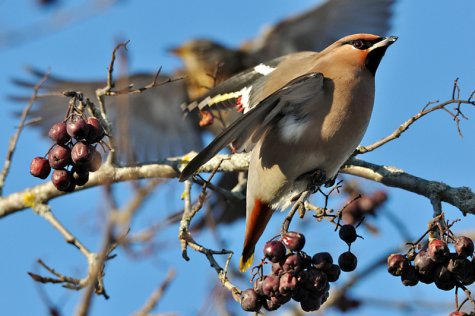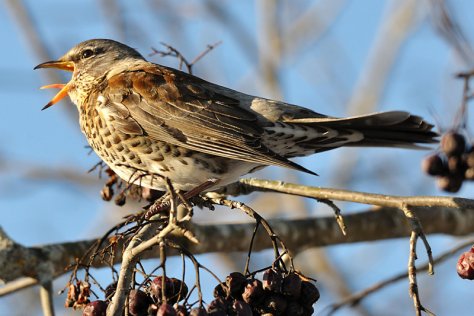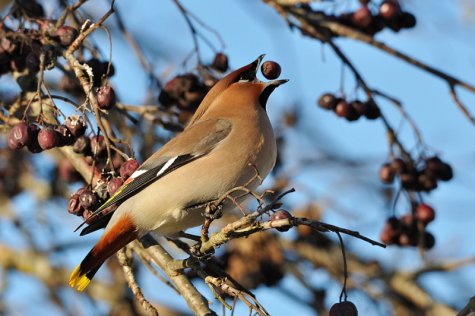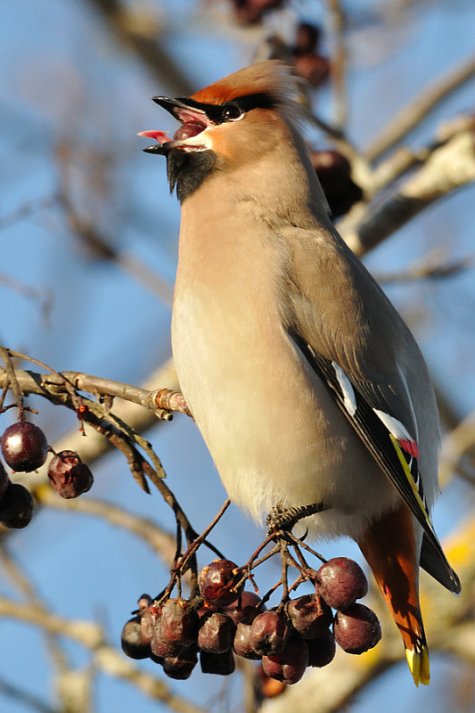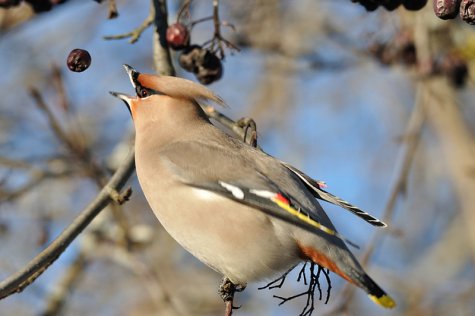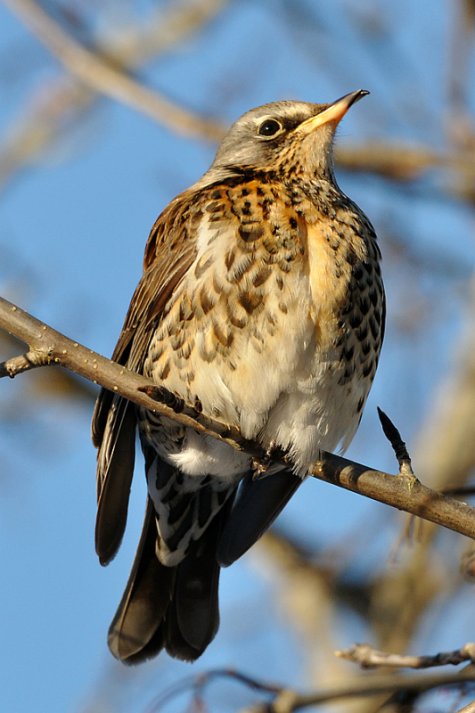Waxwings in the general’s pantry
Text and photos Rein Kuresoo, animalcity.eu/kuresoo/
Translation: Liis
Russian selectioneer Ivan Michurin undoubtedly belongs to the predecessors of today’s GMO creators. Already in his lifetime religious fundamentalists held the inter-species hybrids created by scientists and breeders to be Frankenstein’s monsters. One of many crossbreeds created by Michurin was a cross between common rowan and redhaw (Crataegus sanguinea), a rowan-hawthorn hybrid that even now grows in many Estonian gardens. The berries of this “Granatnaya“ variety are larger, sweeter and juicier than common rowan berries and those who are conversant with kitchen damp can coax culinary wonders out of them.
The creations of God and of the son of the Ryazan province – common rowan and the bastard rowan - grow in my neighbour’s garden side by side. Without rising from my working desk I can confirm that birds seem to prefer the product of the divine bearded creator to the sinful fruits of the transformer of nature. Clearly the orange-red rowanberry clusters catch the birds’ eyes better than the dark red berries of the rowan-hawthorn hybrid. Usually the rowans are eaten already in autumn, birds won’t particularly go for the bastard berries. Even though they swallow the berries whole a sense of taste evidently plays a part in the order of choice – how otherwise explain that the berries on the chokeberry bushes (Aronia sp.) usually are gone already before I get around to the bushes with my basket. To state something valid about avian taste preferences is however difficult without setting up experiments. And the avian sense of taste is a comparatively little studied discipline. Only in 1974 for instance Herman Berkhoudt of the University of Leyden went out to the scientific community with the discovery that mallards have taste buds in the tip of the beak and in the throat as well as on the tongue. Until then the buds had been searched for by the scientific world (at least the English-speaking) but only been found on the tongue of birds.
The rowan harvest of last autumn was ample. According to old folk traditions it means that war will break out. If people of old had been playing bingo they shouldn’t have had to eat famine bread of grain husks, lit by rush lights. War didn’t stay away: in the Spirits Month (October) regiments of winged friends arrived and some battles were fought too. Throughout the whole autumn and the warm year-end fieldfare flocks rustled in the rowans, only icy January pressed most of the thrushes towards south. Some solitary brave birds stayed to defy winter but social life came to an abrupt end. Every remaining thrush now had its own personal resource, which it jealously guarded against species comrades as well as winged vagrants. One fieldfare with a military stance took permanent custody of the rowan-hawthorn bastard that dripped with berry clusters. Its routine of constantly practising drill commands like standing to attention and eyes-left accompanied by tail dips, and scowling habit and raspy voice reminded of General Ants Laaneots. The General who occupied my neighbour’s rowans consistently fought off two fieldfares wintering in the neighbourhood, who in turn had to divide lands and trees with compost heaps and rotting apples between themselves. One of them didn’t have the two beak halves quite aligned, I called it Awryjaw, Viltulõug. The blackbirds who also were busy nearby got a beating from Laaneots such that they disappeared to somewhere beyond the distant blue forests.
On a cold winter’s day happy jingling came from the rowan tree and dampened the harsh barkings of the fieldfare. The General’s pantry had been seized by strangers from the far North – waxwings, who even set up their gipsy camp here. The bohemian and colourful gang did not care a whit about property laws, sustainable development or world order in general. A reality which they however could not ignore was the untiring deterrence capacity of Laaneots. From morning until evening Ants pursued the waxwings in the rowan crowns. To the waxwings fleeing briefly seemed to be a rather exciting event, saving the feeding orgies from becoming too uninspiring. Meanwhile, when two or three waxwings were moving in the rowan the remainder could enjoy their meal in peace. For Gen. Laaneots however this was full-fledged war that moreover must be fought in 15 degrees of cold. The fieldfare’s hundred grams of body weight against the sixty of the waxwings, its sharper beak and more aggressive nature were completely convincing arguments for each individual waxwing, only the waxwings were almost fifty. Already at midday the General was visibly tired – he gasped and shivered by turns. Then, as the waxwings made a little pause in the gulping so that the berries would thaw in the belly and the body temperature return to normal, Ants tried to salvage what could be salvaged and swallowed another fistful of icy berries until they no longer would go down his frozen throat. And the whole merry-go-round started again.
The waxwings had trouble too with swallowing the large frozen berries. Like most birds, waxwings have two backwards-pointing barbs on their tongue. With those, they can get a better hold on a mouthful, and direct it to the throat. When the tongue becomes stiff with cold, food begins to roll around in the beak and will no longer go down. The waxwings tried to get the berries better positioned in the beak by throwing them up in the air and catching them again. But the mouth apparatus, awkward from cold, was not so agile in juggling any more – a great part of the berries grabbed from the clusters simply fell to the ground.
While the hostile parties were engaged in their skirmishes Awryjaw entered the battle. But he didn’t attack the waxwings; his sight was set on his arch-rival – General Laaneots. Fending off Awryjaw was no problem for Ants to start with but his dominance faded daily and hourly.
On the fourth day when the sun (the selfsame sun that once illuminated the Austerlitz battle scenario) broke through the morning clouds and shed light on the battlefield the snow was blood red from the droppings of the birds. At the red patches tits were busy searching for seeds in the piles of waxwing droppings. The waxwings were gone, and so was General Laaneots; only Awryjaw was triumphantly perching in the rowan-hawthorn hybrid, exercising by turns at attention stances and left-right head turns.

